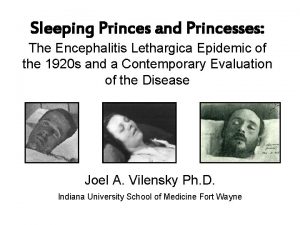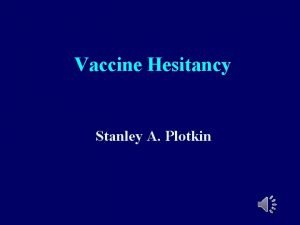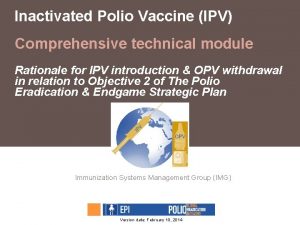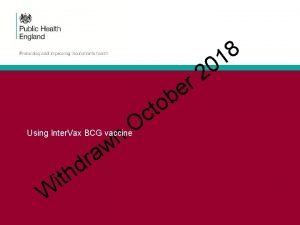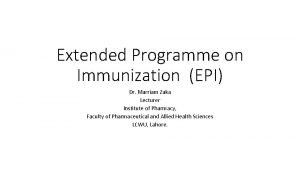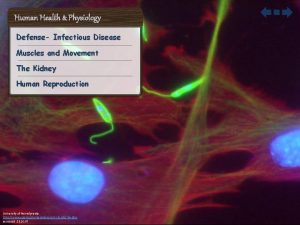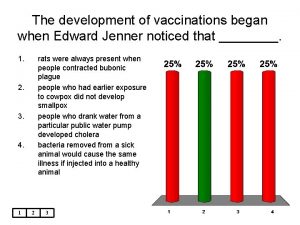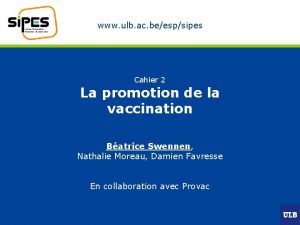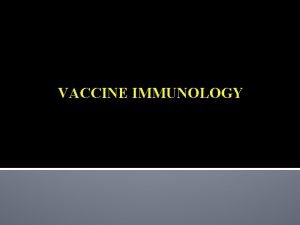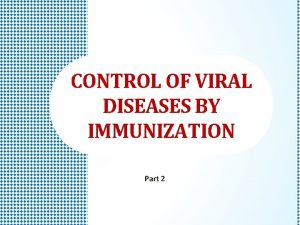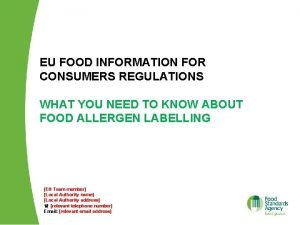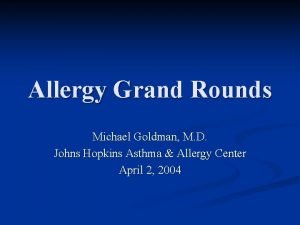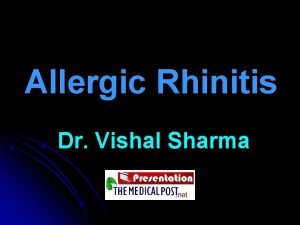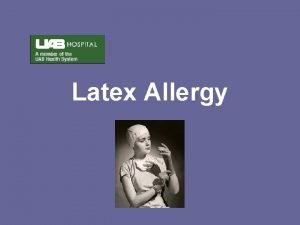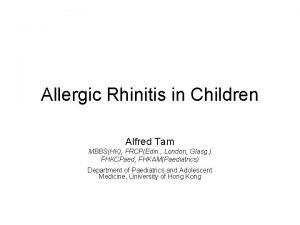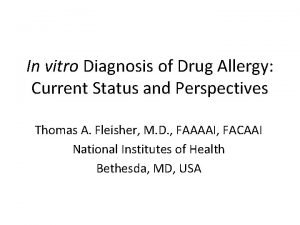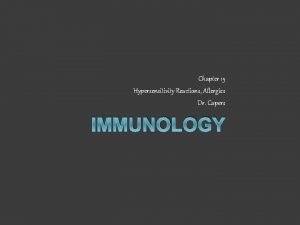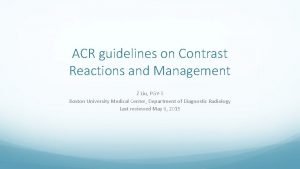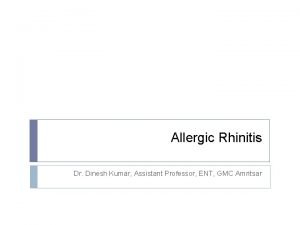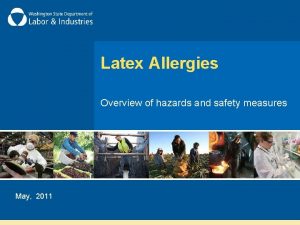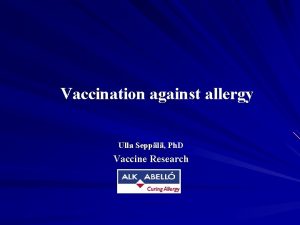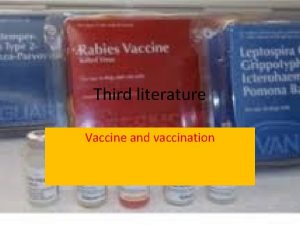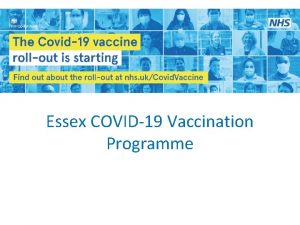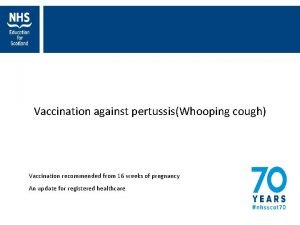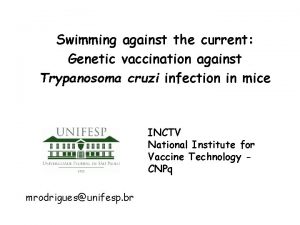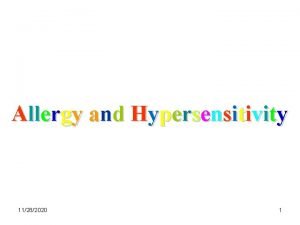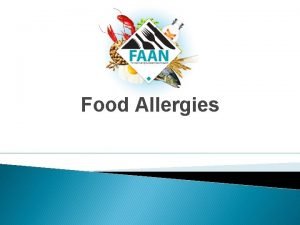Vaccination against allergy Ulla Seppl Ph D Vaccine


























- Slides: 26

Vaccination against allergy Ulla Seppälä, Ph. D Vaccine Research

What is Allergy ? sensitization Ig. E- antibodies X Allergic response(s) • Immediate-type • Delayed- type Non-Ig. E mediated hypersensitivity

What is causing the symptoms ? - Sensitisation > < Clinical allergy CD 23 Allergens Ig. E APC B T-cell HLA- class II Ig. E T-cell “other components” Mast cell B-cell. Ig. M/D Mediator release Andersson A-C, Seppälä U, Rudin A. Activation of human neonatal monocyte-derived dendritic cells by lipopolysaccharide: Down-regulation of birch allergen-induced Th 2 responses. Eur J Immunol. 2004; 34(12) : 3516 -24.

Most common sources of inhalant allergens Phleum pratense Betula verrucosa Dermatophagoides pteronyssinus Felis domesticus

Vespid & Bee venom allergens Apis mellifera Vespula vulgaris

Allergens and Allergen Diagnostics: Clinical diagnosis In vitro: specific Ig. E In vivo: SPT / allergen extracts

What is allergy vaccination? § Allergens are administered: in different doses at different sites } ”the immune response is changed” - Allergy vaccination Tolerance - Allergen Reaction

What is allergy vaccination ? Subcutaneous Immunotherpy /SCIT

What is allergy vaccination ? Sublingual Immunotherapy / SLIT

Allergen Specific Immunotherapy Induction a state of tolerance by utilizing T - lymphocytes as targets I. II. Anergy = clonal silence or actual clonal deletion of allergen-reactive T-cells Immunoregulation-induced immune deviation, leading into different cytokine milieu in a target tissue Rossenwasser LJ and Gelfand EW. Immunotherapy with antigens and epitopes. Am. J Repir. Cell. Mol. Biol. 1999: 21; 4 -6.

Proposed mechanisms in immunotherapy Tregs/ CD 4+CD 25+ IL-10/TGF-b Th 2/Th 1 SIT + Ig. G 4 Till SJ et al. Mechanisms of immunotherapy. J Allergy Clin Immunol 2004; 113: 1025 -34.

Targeting therapeutic tools ? Sensitisation Allergic Reaction T-helper-cell differentiation Allergen APC IL-10 - IL-12 + + Th 1 - + PGE 2 + + Eosinophil IFN-g Th 0 APC Cell mediated immunity IFN-g Ig. G- production DTH IFN-g TNF-a APC Late Phase Reaction CD 8+ T-cells IL-4 -g IL-4 IL-5 Immediate Reaction Th 2 IL-4 Ig. E IL-4 Mast cells and Basophils (IL-13) Mast Cell B-cell Allergen

What are the tools to cure allergy? CURRENT METHODS • natural allergen extracts • anti-allergy drugs e. g. antihistamines

What are the tools to cure allergy? FUTURE METHODS DNA - vaccines r. DNA - vaccines Reichert JM and Paquette. Therapeutic recombinant proteins: Trends in US approvals 1982 – 2002. Curr Opin Mol Ther. 2003: 5; 139 -47.

Therapeutical recombinant proteins / r. DNAs allergen + Cp. G/ISS r. Igs Fcg-Fel d 1 Daocheng Z et al. A chimeric human-cat fusion protein blocks cat-induced allergy. Nature Medicine 2005; 11(4): 446 -49.

Formulation of allergen vaccines by use of various adjuvants ”An adjuvant is an agent which, while not having any specific antigenic effect in itself, may stimulate the immune system, increasing the response to a vaccine. ” Aluminium hydroxide Bacterial origin mucosal adjuvants – Cp. G ODN, – Monophosphoryl lipid A (MPL) – Cholera toxin /CT (Vibrio cholera), entero toxin /LT (Escherichia coli) Carbohydrates / (CBPs) Microencapsulated allergen vaccines Francis JN, Durham SR. Adjuvants for allergen immunotherapy: experimental results and clinical perspectives. Curr Opin Allergy Clin Immunol. 2004 Dec; 4(6): 543 -8. Freytag LC, Clements JD. Mucosal adjuvants. Vaccine. 2005 Mar 7; 23(15): 1804 -13.

How to monitor allergen immunotherapy ? – improved clinical phenotype – serum Ig. E / Ig. G 4 –levels Ig. E / Ig. G 4 – decrease in number of mast cells and eosinophils after allergen provocation – modified and/or reduced production of cytokines – BIOMARKERS ? ! Walker C and Zuany-Amorim. New trends in immunotherapy to prevent atopic diseases. TRENDS Pharm Sci. 2001; 22(2): 84 -90.

How to monitor allergen immunotherapy ? A prequisite for a vaccine is the knowledge of how to induce Treg cells in vivo DNA / protein arrays + ”omics” technologies Sauer S et al. Miniaturization in functional genomics and proteomics. Nature Reviews Genetics. 2005; 6: 465 -76.

”Genomics and proteomics of allergic disease” Identification of the disease genes; for design of new classes of anti-inflammatory compounds Identification of expression and function of proteins; to obtain increased knowledge of mechanisms underlying allergic disease Identifiction of novel biomarkers TODA M and ONO SJ. Genomics and proteomics of allergic disease. Immunol. 2002; 106: 1 -10.

Microarray technology DNA – microarrays: • High – throughput analysis and expression of multiple genes or single nucleotide polymorphisms (SNIPs). Karp CL et al. Identification of complement factor 5 as a susceptibility locus for experimental allergic asthma. Nat Immunol 2000; 1: 181 -7. Miklos GL, Maleszka R. Microarray reality checks in the context of a complex disease. Nat Biotechnol. 2004 May; 22(5): 615 -21.

Microarray technology Protein –microarrays: • examine the time course of cytokine secretion pattern by cell cultures, T- cells, DCs, Mast Cells / Basophils • examine expression profiles of cells expressing recombinant allergens Schweitzer B et al. Multiplexed protein profiling on microarrays by rolling-circle amplification. Nature Biotechnology, 2002; 20: 359 -65.

Proteomics technology • investigation of the influence of SNIPs in gene expression and function of the proteins = elucidation of disease gene expression transcriptome = proteome • follow-up of the Th 1/Th 2/Treg – profiles – up / down regulation of signal transduction pathways, marker molecules • plasma / serum proteomics • characterization cellular responses against natural and/or modified r. DNA Chromy BA et al. Proteomic Analysis of Human Serum by Two-Dimentional Differential Gel Electrophoresis after Depletion of High-Abundant Proteins. J Proteome Res. 2004; 3: 1120 -1127.

Proteomics in Allergy Research Fehninger T. E. et al. Exploring the context of lung proteome within the airway mucosa following allergen challenge. J Proteome Res. 2004; 3: 307 -20.

Identification of the disease genes or biomarkers p. I MW Identification of the proteins / peptides by Mass Spectrometry DATABASE SEARCH Weingarten P et al. Application of proteomics and protein analysis for biomarker and target finding for immunotherapy. Methods Mol Med. 2005; 109: 155 -74.

Biomarker discovery: PEPTIDOMICS Peptides are ideal candidates for biomarkers Isolation/ measurement of biomarkers from blood - clinical application Proteases liberate biomarkers – processing and specific degradation products – discovery tool ! Hormones Cytokines Growth factors etc. Schulte I. et al. Peptides in body fluids and tissues as markers of disease. Expert Rev Mol Diagn. 2005 Mar; 5(2): 145 -57.

Conclusions A B C D “New vaccines”
 Encephalitis lethargica
Encephalitis lethargica Mandatory vaccination
Mandatory vaccination Vaccine dose schedule
Vaccine dose schedule Dog vaccination perry county
Dog vaccination perry county Niccolo paganini powerpoint
Niccolo paganini powerpoint Vaccine vial monitors
Vaccine vial monitors Epi schedule pakistan 2021
Epi schedule pakistan 2021 Defaulter vaccination schedule
Defaulter vaccination schedule Lokstallarna jönköping vaccination
Lokstallarna jönköping vaccination Oogenesis defination
Oogenesis defination Poultry vaccination schedule
Poultry vaccination schedule Edward jenner
Edward jenner Vaccination bruxelles
Vaccination bruxelles Advantages and disadvantages of vaccines ppt
Advantages and disadvantages of vaccines ppt Vaccination schedule in palestine
Vaccination schedule in palestine Eu food information for consumers regulation
Eu food information for consumers regulation Allergy
Allergy Allergic crease adalah
Allergic crease adalah Latex allergy rash pictures
Latex allergy rash pictures World allergy organ j
World allergy organ j Rhinitis allergy
Rhinitis allergy Allergy
Allergy Latex food syndrome
Latex food syndrome Capers allergy
Capers allergy Acr contrast reaction
Acr contrast reaction Management of allergic rhinitis
Management of allergic rhinitis ü latex
ü latex
